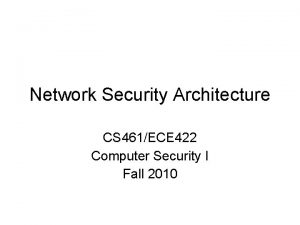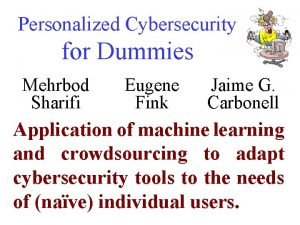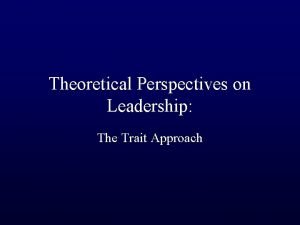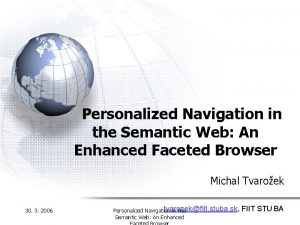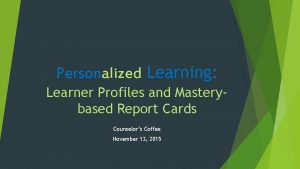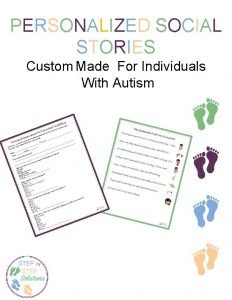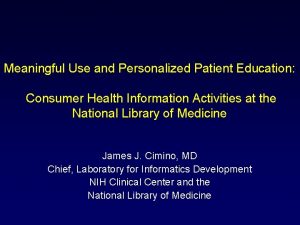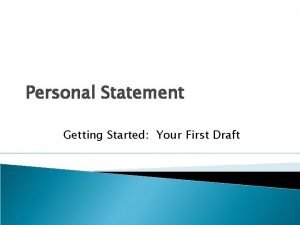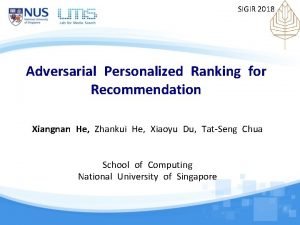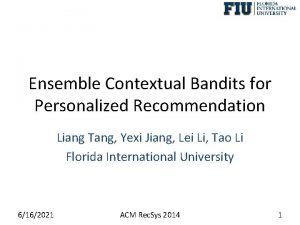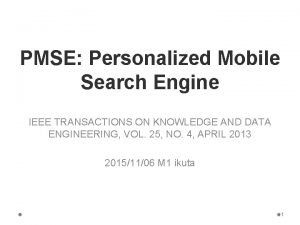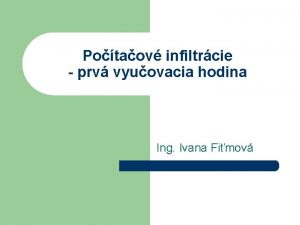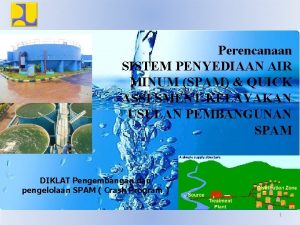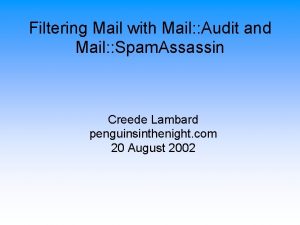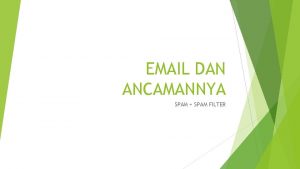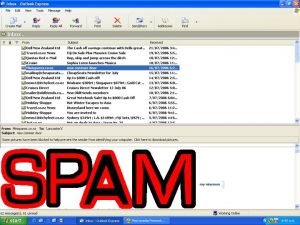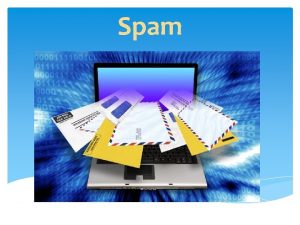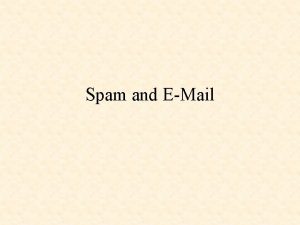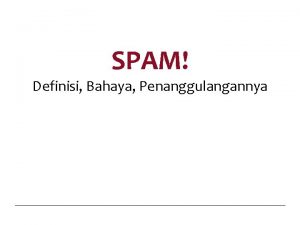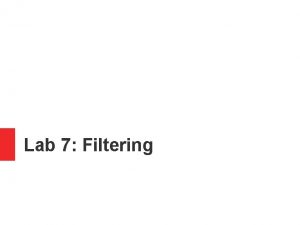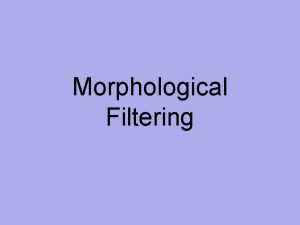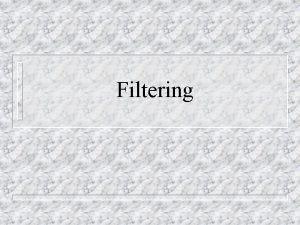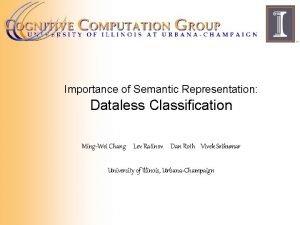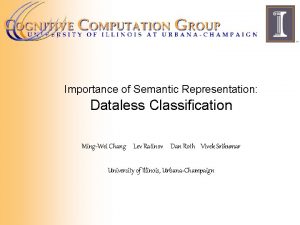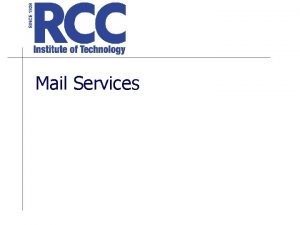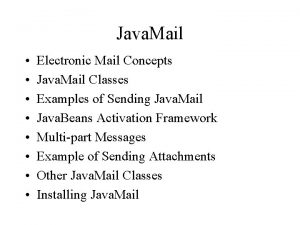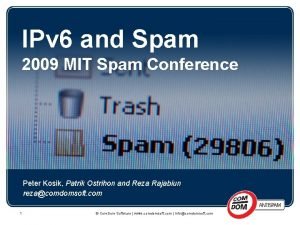Personalized Spam Filtering for Gray Mail Mingwei Chang















![For more details, check the paper and [Chang et al. KDD-08] KDD-08 � Global For more details, check the paper and [Chang et al. KDD-08] KDD-08 � Global](https://slidetodoc.com/presentation_image_h2/8174fd9ab62db691723b0a2a62e8e77f/image-16.jpg)






- Slides: 22

Personalized Spam Filtering for Gray Mail Ming-wei Chang University of Illinois at Urbana-Champaign Wen-tau Yih and Robert Mc. Cann Microsoft Corporation ∗This work was done while the first author was an intern at Microsoft Research.

� Good mail messages users definitely want � Spam mail messages users definitely don’t want � Gray mail messages some users want and some don’t Unsolicited commercial email (sometimes useful) Newsletters that do not respect unsubscribe requests Either prediction (spam or good) is justifiable

Gray Mail: User's View I bought a Game Boy Advance at games. com A week later, I started to receive advertising email… Good Mail! GBA Games 50% off!

Gray Mail: Another User's View Alan bought a Game Boy Advance Game at games. com A week later, Alan started to receive the same advertising email… Junk Mail! GBA Games 50% off!

Gray Mail: System's View GBA Games 50% off! Black GBA 50% off! We call these messages which users have different opinions gray mail.

� Show that gray mail is common and difficult Analysis done using Hotmail Feedback Loop data � Show to deal with gray mail we need to incorporate user preference � Propose a large-scale personalization algorithm Partitioned Logistic Regression [Chang et al. KDD-08] Lightweight and scalable Catch 40% more spam in low FP area for gray mail Improve spam filter with partial feedback

�Dataset – Hotmail Feedback Loop Hotmail messages labeled as good or spam Obtained by polling over 100 K users daily Messages from Apr ~ May, 2007 �Strategy: Campaign Detection Campaign: a set of “almost identical” mail Gray campaign: campaign that users disagree on the labels Gray mail: messages in gray campaign

About 21% are Gray Mail ! About 8% are Gray Mail !

�There are quite a few gray messages Gray mail detected by campaign occupy about 8% or 21% of all mail �Spam filtering for gray mail Messages in all campaigns ▪ TPR@FPR=10% is difficult! ~ 80% Messages in gray campaigns ▪ TPR@FPR=10% �We ~ 15% !! need to address the issue of gray mail!

� Major problem of gray mail: Noisy label ? Past works show that removing noise improves some tasks significantly [Brodley and Friedl 99], [Lawrence and Schölkopf 01] � Clean label noise using campaign detection For a given message, find the campaign it belongs to Replace the label by the majority vote � Our verification procedure We clean the label in the training data Train a classifier on cleaned labeled data then test it Training: Jan-Mar 07, Testing: Apr-May 07

q Label cleaning brings limited improvement q The major problem: there are just no “right answers” q Alternative: incorporating user preference

�Is user preference the bottleneck? �Remove user preference in the testing data Test on cleaned data, if we get huge improvement ▪ The bottleneck is likely to be user preference This analysis gives the potential upper bound of the gain of incorporating user preference �Procedure Train a classifier with original labeled data Test the classifier on cleaned testing data

Increase TP rate from ~55% to ~85%

� Solution 1: User’s safe/block list Require user’s participation Need to modify the list for each new sender � Solution 2: Personalized spam filtering Usually means building individual models using personalized training sets for each user [Segal 07] Great potential, but hard to implement for large scale systems Hotmail: >200 million users ▪ Remove user preference in the testing data ▪ Lack of labeled data from each user � Our solution: a lightweight personalization system Does not require lots of user’s participation Highly scalable

� On one hand, training a model with content information only No user preference � On the other hand, training user specific content models Intractable � Our solution: train content model and user model separately Introduce a conditional independence assumption � Combine two models in the testing time � Training user model, , is relatively easy
![For more details check the paper and Chang et al KDD08 KDD08 Global For more details, check the paper and [Chang et al. KDD-08] KDD-08 � Global](https://slidetodoc.com/presentation_image_h2/8174fd9ab62db691723b0a2a62e8e77f/image-16.jpg)
For more details, check the paper and [Chang et al. KDD-08] KDD-08 � Global decision threshold: � Our model: lightweight personalization Each user has his own threshold User’s threshold can be derived from : user id � Calculating threshold is easy

� Training/Testing Split From Jan, 2007 to Mar 2007 Training From Apr, 2007 to May 2007 Testing Focus on messages sent by mixed sender � Mixed Senders: Senders who send both good and spam mail Test data: collection of the messages sent by mixed senders A super set of gray mail. Also contain good and spam mail. We want to test our algorithm on a large dataset � This dataset is hard: TPR @ FPR = 0. 1 is 38. 2%

TPR @ FPR=0. 1 : 38. 2% 60. 8%,

�We can improve spam filtering significantly By assigning a threshold to each user �The solution is scalable and easy to implement But, it requires complete feedback from users � For most users, only partial feedback is available Safe/block lists, junk mail reports, deleted mail � Given partial feedback, how much can we gain?

� Junk mail report: report spam which � In the simulation, we vary the report appears in the inbox rate to get different level of partial feedback The number of reported messages The estimated number of successfully caught spam The total number of messages sent to this user

TPR @ FPR=0. 1 improves from 37 % to 43% with 20% report rate The Report Rate of Misclassified Spam Mail

� Gray mail is a common and difficult problem We need to incorporate user preference to solve it � Our lightweight personalization algorithm Simple, scalable and easy to implement Complete feedback ▪ TPR @ FPR=0. 1 improves from 38. 2% to 60. 8% Demonstrate that the model can be improved using partial feedback � Possible future work Additional forms of feedback (black/white list, folding behavior)
 Ingress filtering vs egress filtering
Ingress filtering vs egress filtering Priority mail vs priority mail express
Priority mail vs priority mail express Google docshttps://mail.google.com/mail/u/0/#inbox
Google docshttps://mail.google.com/mail/u/0/#inbox Parallelism examples
Parallelism examples Oyunlarm
Oyunlarm Personalized recommendations
Personalized recommendations Personalized power motive
Personalized power motive Zaponet
Zaponet Institute for personalized learning
Institute for personalized learning Personalized navigation
Personalized navigation Personalized learning learner profile
Personalized learning learner profile Personalized social stories
Personalized social stories Personalized patient education
Personalized patient education Personalized statement messaging
Personalized statement messaging Hexiangnan
Hexiangnan Medicine
Medicine Contextual bandits for personalized recommendation
Contextual bandits for personalized recommendation All to one reduction
All to one reduction Personalised mobile search engine
Personalised mobile search engine Nevyžiadaná pošta spam
Nevyžiadaná pošta spam No te creas los chollos y los regalos
No te creas los chollos y los regalos Nie spam
Nie spam Perencanaan teknis spam
Perencanaan teknis spam
